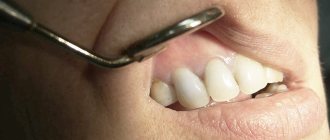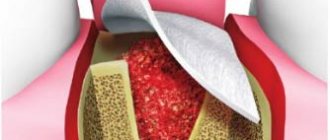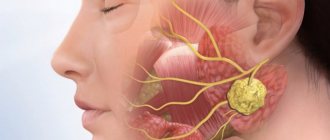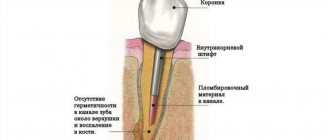The structure of the formations, their size and type of contents vary, depending on the location and duration of the onset of the pathological process. They are true (inside lined with epithelial cells) and false (without lining). Based on the type of appearance, neoplasms are divided into:
- retention (usually formed due to a disruption in the process of outflow of secretions in tissues and organs, occurring in the mammary glands, uterus, cervix, ovary, etc.);
- ramolitic (usually found in the ovaries, brain and spinal cord, can form in areas of tissue necrosis, for example after a stroke);
- parasitic (appears in different organs, is the shell of the parasite);
- traumatic (due to bruises);
- dysontogenetic (usually congenital, include different tissues of the embryo);
- tumor (formed due to metabolic disorders, have cavities filled with physiological fluids).
Cysts in women and men: symptoms and treatment
In the initial stages of development, cystic elements do not have symptoms. When they grow and suppurate, they manifest themselves differently, depending on the etiology, location, composition of the contents and size. For example, when the ovary is damaged, women complain of a feeling of heaviness and compression of the lower abdomen, pain during menstruation, cycle disruption, etc. With kidney pathology, the lower back hurts and aches, it is difficult to empty the bladder, and jumps in blood pressure are noted.
Diagnostics
Diagnostic methods depend on the location of cystic formations. Most often this is an ultrasound, but MRI, CT, and radiography can also be prescribed. Laboratory tests are also carried out - blood and urine.
Surgery
The intervention tactics are determined by the doctor based on the location, size of the cystic formation and the patient’s complaints. The classic technique is scalpel excision of the tumor along with adjacent tissues. Today, such an operation is performed mainly laparoscopically using an endoscope. Laparoscopy of a cyst is less traumatic, the patient’s recovery lasts one day. You can also choose the method of aspiration (suction) of the contents with further cauterization of the capsule with a laser, liquid nitrogen, radio wave or a special drug for sclerosis of the walls. The removed lesion must be sent for histological examination.
Is surgery necessary?
When making such a diagnosis, many patients wonder whether the cyst needs to be removed. Some tumors, if they are small and do not bother the person, can remain under observation. Others, such as cervical cysts, can have consequences: bacteria accumulate in them, which sooner or later will lead to inflammation or suppuration. The need for removal should be discussed with your doctor.
Causes of breast cysts
Mastopathy is a hormonally dependent pathology that occurs in women of reproductive age. Cysts as a manifestation of the fibrocystic form of pathology appear in 50-60% of patients. Small cysts can be found in young women; after 35 years, formations larger than 1-2 cm are more often detected.
Women's breasts are sensitive to changes in the concentration of estrogen in the blood. With the appearance of relative or absolute hyperestrogenism, the likelihood of dyshormonal pathologies increases. The main risk factors for developing breast cysts are the following:
- reproductive history - absence of pregnancies and childbirth, first late pregnancy, early menarche, abortion, IVF, refusal to breastfeed;
- endocrine pathologies – the risk is higher for diseases of the ovaries, thyroid gland and adrenal glands;
- problems with the digestive system - impaired utilization of hormones in the liver in various forms of hepatitis;
- neurogenic causes - the appearance of cysts is associated with stress, sexual dissatisfaction, head and neck injuries, increased intracranial pressure, neuroinfections;
- metabolic disorders - with diabetes and excess weight, a hormonal imbalance appears, which leads to an increase in estrogen in the blood.
Breast cysts are often encountered by women who suffer from uterine fibroids, endometriosis and other gynecological pathologies.
The main types of cystic formations
Ovarian
This is a fluid-filled bladder that causes the ovary to enlarge, leading to pain and sometimes infertility. The main reason for its appearance is hormonal imbalance. The disease often occurs without symptoms; when the formation is large, the cycle is disrupted, pain is felt in the lower abdomen, a false urge to urinate occurs, and bleeding occurs outside of menstruation. Methods of surgical treatment: oophorectomy (complete removal of the ovary), laparoscopic cystectomy (excision of the cyst), adenxectomy (surgery to remove the uterine appendages). In most cases, the choice is not classical surgery, but gentle endoscopic removal of the cyst while preserving the patient’s reproductive function.
Read more about ovarian cyst removal
Coccygeal
Most often occurs in men aged 15-30 years. It is an opening in the area of the gluteal fold, approximately 10 cm from the anus. Externally it looks like a fistula. It can be congenital or acquired - due to too much hair in this area. It manifests itself as pain when walking, sitting, redness of the tailbone, a feeling of discomfort and the presence of a foreign body in the area where it is located. At a later stage, pus is released from the hole.
Read more about the treatment of coccygeal cyst
Bartholin gland
Appears due to blockage of the gland duct due to infection or chronic inflammation. The formation has a capsule and is filled with secretion, which gradually gels. If it is large, it interferes with walking and sitting, makes intimate intimacy inaccessible, and can become infected and lead to an abscess. Usually reaches 2 cm, but there are formations up to 9 cm. The main causes are chronic bartholinitis, candidiasis, bacterial vaginosis, decreased local immunity.
Where and how to remove a Bartholin gland cyst
Eye
A hollow formation filled with non-inflammatory fluid - products of the activity of the cornea or conjunctiva. May originate from the cornea, iris, conjunctiva and other eye membranes. Causes: inflammation and trauma, congenital anomalies. The disease is manifested by pain, a feeling of fullness, blurred vision, and the presence of translucent dots in the field of vision.
Maxillary sinus
A cavity containing fluid and having a membrane attached to the wall (usually the lower) of the maxillary sinus. A cystic formation can be true (its walls consist of mucous membrane) or pseudocyst (the mucous membrane is split and fluid accumulates in it). It manifests itself as headache, difficulty breathing through the nose, a feeling of fullness and heaviness in the eye and cheek area, mucus discharge from the nose and its flow down the wall of the pharynx, discharge of yellow transparent fluid from the nose, frequent sinusitis with suppuration. It is formed due to the peculiarities of the anatomical structure of the nose, blockage of the excretory duct of the glands of the maxillary sinus, inflammation of the teeth, spreading to the roots.
Read more about the treatment of abscesses and cysts of the ENT organs
Mammary gland
A cavity bounded by a capsule of connective tissue and filled with fluid is formed in the ducts and can be single or multiple. It is formed due to an increase in the duct of the mammary gland, the accumulation of secretions in it. The lesion may be round, oval, or irregular in shape. The disease is asymptomatic for a long time; over time, pain and burning appear in the mammary gland, and may be accompanied by suppuration and inflammation. One of the varieties is a fatty cystic formation that occurs when the sebaceous gland of the skin is blocked and filled with secretions. The main provoking factors are mastitis, thyroid disease, inflammation of the genital organs, and ovarian dysfunction.
Learn more about symptoms and treatments
Uterus and cervix
These are dilated and clogged glands, inside of which secretions (mucus) accumulate. The disease occurs against the background of endocervitis, cervitis. Provoking factors: abortion, childbirth, infections, menopause, hormonal imbalance, use of an intrauterine device, infections. Nabothian cystic formations are localized in the vaginal area of the uterus and are not removed until they reach a certain size. Retention occurs due to an excessive amount of secretion in the gland duct. The disease is often asymptomatic; its indirect signs are frequent inflammation.
Read more about surgical treatment of uterine and cervical cysts
Brain
A cystic formation is an accumulation of fluid in the substance or membranes of the brain. When large in size, it entails intracranial hypertension and puts pressure on the surrounding brain structures. Can form at any age. Depending on the location, cerebral (intracerebral) and arachnoid formations are distinguished. The first are found in the internal structures of the brain, in areas of necrosis. The second ones are in the meninges. Provoking factors: inflammatory diseases, trauma, including birth, cerebrovascular accident, parasites, complications after surgery. They manifest themselves as nausea, a feeling of pressure on the eyes, decreased performance, sleep disturbances, pulsation or noise in the head, and visual impairment.
Thyroid gland
Small formations (up to 5 mm) may not have pronounced symptoms. If the thyroid cyst has dense inclusions and a complicated structure, then special studies (for example, ultrasound), tests and biopsy are needed, because such a condition may be a sign of malignant degeneration.
Read more about surgical treatment of thyroid cysts
Larynx
Cysts of the larynx can be located in any part of the larynx. They do not grow into the mucous membrane, but grow towards the lumen of the larynx and thereby narrow it. The cause of retention cysts is blockage of the excretory ducts of the laryngeal glands. There are cysts of the vocal cords that arise due to constant irritation.
More information about surgical treatment of laryngeal cyst (laryngocele)
You can find out the prices for cyst removal endoscopically or by another method, as well as the cost of preoperative diagnostics on our website or by calling honey. +7 (812) 435 55 55.
Prevention
The best prevention for the development of ovarian cysts is periodic examinations by a gynecologist and a transvaginal ultrasound to assess the condition of all organs of the female reproductive system. Every six months, every woman needs to visit a gynecologist to avoid the development of not only cysts, but also other diseases, including cancer.
Timely consultation with a doctor helps to identify the disease at the earliest stages and begin treatment immediately.
In addition, a woman should avoid excessive stress and sports activities, which disable the hormonal system and can trigger the development of ovarian cysts. Take care of your health, and if unpleasant symptoms appear, trust a specialist.
Gynecologists at MC “Health” are ready to help patients with any problems in maintaining women’s health. An ovarian cyst of any kind is not a death sentence. Our specialists will conduct a full examination, determine the type of cyst and prescribe appropriate treatment as soon as possible.
Symptoms of retroperitoneal cysts
Clinical manifestations of the pathological condition in the form of a cyst are as follows:
- an increase in the size of the abdomen and a change in its shape;
- pain symptoms localized in the abdominal area;
- disturbances in the processes of defecation and urination;
- intestinal obstruction;
- feeling of weakness, lack of appetite;
- nausea and vomiting.
When the nerves of the retroperitoneal space are damaged, the patient experiences severe acute pain localized in the abdomen, lower back, and lower extremities.
Our doctors
Prokhorov Yuri Anatolievich
Surgeon, head of the surgical service of CELT, candidate of medical sciences, doctor of the highest category
33 years of experience
Make an appointment
Gordeev Sergey Alexandrovich
Surgeon, Candidate of Medical Sciences, doctor of the highest category
42 years of experience
Make an appointment
Lutsevich Oleg Emmanuilovich
Chief Surgeon of CELT, Honored Doctor of the Russian Federation, Chief Specialist of the Moscow Department of Health in Endosurgery and Endoscopy, Corresponding Member of the Russian Academy of Sciences, Head of the Department of Faculty Surgery No. 1 of the State Budgetary Educational Institution BPO MGMSU, Doctor of Medical Sciences, Doctor of the Highest Category, Professor
43 years of experience
Make an appointment
What studies are carried out for ovarian tumors
- Bimanual examination remains relevant even with the most modern equipment, as it allows one to obtain important information.
- Speculum examination provides access to the cervix for examination, allows you to take aspirate and examine the endometrium.
- Washing and puncture of the abdominal cavity for cytological examination.
- Ultrasound using vaginal and abdominal sensors.
- Nuclear MRI and computed tomography allow for precise layer-by-layer studies to identify the presence of metastases in the lymph nodes.
- Ultrasound and mammography - examination of the mammary glands.
- Study of the condition of the endometrium.
- Examination of the intestine for the presence of a tumor (irrigoscopy, rectromanoscopy).
- Examination of the gastrointestinal tract, since the appearance of a metastatic tumor in the pancreas, intestines, and stomach is possible.
- Tumor markers. Increase in tumor marker CA-125 - more than 35 units. indicates an increased risk of developing an oncological process. But this statement is not always true, since there are cases where a significant excess of the tumor marker norm in endometrial ovarian cysts and endometriosis is not related to oncology.
- Carrying out laparoscopy
FAQ
During the examination, I was diagnosed with an ovarian cyst, what should I do if I plan to get pregnant?
The presence of a follicular cyst can interfere with pregnancy, since the hormone estradiol secreted by the cyst prevents the growth of a new follicle. In addition, a follicular cyst is formed from a follicle that has not ruptured, which means there was no ovulation. In this situation, you need to understand the reason for the lack of ovulation, then further tactics will be clear, however, your attending physician must clarify the nature of the cyst and determine further tactics.
Is it possible to cure a cyst with folk remedies?
Folk remedies do not belong to evidence-based medicine, and therefore cannot be recommended for use.
Womenfirst
- Gynecology: national guide / ed. G. M. Savelyeva, G. T. Sukhikh, V. N. Serov, V. E. Radzinsky, I. B. Manukhin. — 2nd ed., revised. and additional - M.: GEOTAR-Media, 2022. - 1008 p.
- Clinical protocols (gynecology)/ A.A. Schmidt, A.A. Bezmenko, D.I. Gaivoronskikh. – St. Petersburg: SpetsLit, 2022. – 143
- Ultrasound gynecology: course of lectures: in two parts / M.N. Bulanov. – 4th ed. – M.: Vidar-M Publishing House, 2017
- Atlas of ultrasound diagnostics in gynecology / T.M. Umarov, L.T. Khamidova. – M.: MEDpress-inform, 2022. – 320 p.: ill.
RUS2132955 from 04/08/2020
Diagnosis of retroperitoneal cysts
Diagnosis of such cysts is seriously difficult due to the fact that they are located in free tissue. Our specialists pay attention to the correct diagnosis, carrying out:
- inspection and palpation;
- Ultrasound scanning of the affected area;
- computed tomography.
In this way, they establish the localization of the cyst and the place of its attachment. The results of general tests of urine and blood, and malignant processes - histology through puncture sampling of material help to exclude the presence of an inflammatory process.
What types of ovarian tumors are identified:
- Dermoid
- with epidermal cells in the dermis (teratoma); - Endometrioid cysts
formed as a result of endometriosis; - Cytadenomas
are benign formations in the form of a large cyst (mucinous, serous).
The following tumor-like formations are distinguished:
- Follicular cysts
- when the follicle continues to grow in the absence of ovulation. The most common are follicular single-chamber formations with thin walls. They are most often located on one side. The fluid accumulated inside the formation includes estrogens produced by the internal lining. The liquid has a yellowish tint and is transparent. The process of formation of this type of cyst starts if an egg does not come out of the dominant follicle. The formation grows due to the transudation of fluids from adjacent lymphatic vessels. In some cases, small cysts (no more than 4 cm) resolve on their own during menstruation. Then no treatment is required. A cyst that continues to grow and exceeds 5 cm requires attention. Drug therapy does not produce positive results. Requires surgery. - Corpus luteum cysts
- are formed as a result of circulatory disorders after ovulation as a result of the action of the pituitary hormone; Corpus luteum cysts are the next most common and have the following features: They are structured similarly to the structure of the corpus luteum; - Single-sided, thick-walled;
- Formed only during reproductive age;
- They have an increased risk of rupture and provoke hemorrhage.
- Usually the disease develops asymptomatically and is often discovered during an examination by a gynecologist;
- If there is an inflammatory process, pain is possible in the lower abdomen;
- The cyst is palpable on the side of the uterus, smooth and elastic;
- There are frequent cases of such a cyst occurring in pregnant women; after termination of pregnancy, the formation resolves on its own.
are single-chamber formations formed from appendages; A paraovarian cyst is formed from the epididymis. This is a round tumor-like cavity with a chamber containing liquid with a predominant protein component. It grows slowly, can reach 20 cm, does not resolve on its own, and does not turn into a malignant form. As they increase, the walls become transparent. It is not anatomically connected to the ovary, therefore it does not affect its functioning. It has a high risk of complications - suppuration, torsion of the leg, rupture. May cause problems with conception, as it may compress the fallopian tube. During pregnancy it is asymptomatic and detected at the first screening.









